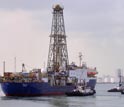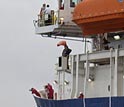News Release 09-086
Newly Rebuilt Drillship JOIDES Resolution Enroute to Port Call
Scientific drilling vessel to dock in Honolulu harbor, May 5-9, 2009
April 29, 2009
This material is available primarily for archival purposes. Telephone numbers or other contact information may be out of date; please see current contact information at media contacts.
The drillship JOIDES Resolution ("JR") has returned to international operations, and will make a port call in Honolulu, Hawaii, May 5-9, 2009.
When it arrives, an international team of scientists studying seafloor sediments will have completed the first of two nine-week Integrated Ocean Drilling Program (IODP) expeditions to the equatorial Pacific Ocean.
After more than two years of rebuilding, the JR has new capabilities that include an upgraded sub-sea camera system, improved core handling capability, and new core research stations and software, among others.
The forward half of the ship, including berthing areas, galley, science laboratories and core processing areas are all new.
The National Science Foundation (NSF), the University of Hawaii at Manoa's School of Ocean & Earth Sciences & Technology (SOEST), and the Integrated Ocean Drilling Program-US Implementing Organization will welcome guests to the ship on Wednesday, May 6, 2009.
"The Resolution carries science teams whose research will help us better understand Earth's current climate and its ancient sea levels," said NSF Director Arden L. Bement, Jr. "This research will help resolve the puzzles of continental drift, volcano formation, and the onset of earthquakes."
During the first phase of IODP drilling operations from 2004-2006, 12 expeditions were conducted. Ten of those expeditions were conducted aboard the JR prior to its redesign.
"I am very proud and excited to see the JOIDES Resolution back in action--providing the world's science community with unique information essential for unlocking the evolution of our planet, and providing the framework for understanding our future changing climate," said Robert Gagosian, president of the Consortium for Ocean Leadership.
"Having twice sailed as an ocean drilling expedition co-chief scientist, I'm especially pleased to see the lab upgrades and return to operations of this amazing educational asset," said Brian Taylor, dean of SOEST.
IODP is an international marine research program dedicated to advancing scientific understanding of the Earth through drilling, coring, and monitoring the subseafloor.
The program operates three drilling platforms: Chikyu, a riser-equipped vessel provided by Japan; the JOIDES Resolution, the newly refurbished research vessel provided by the United States; and mission-specific drilling platforms, such as jack-up rigs similar to those that drill for oil in the Gulf of Mexico, managed by ECORD, the European Consortium for Ocean Research Drilling.
During the first week of May 2009, all three platforms will be conducting investigations.
The Chikyu will disembark from Shingu in Japan for the Nankai Trough Seismogenic Experiment (NanTroSEIZE), a multi-expedition drilling project focused on an earthquake-generating zone.
The JOIDES Resolution will continue the Pacific Equatorial Age Transect (PEAT) Expedition, sampling Pacific Ocean sediments and studying the transition from climates that existed 15-50 million years ago to today's conditions. Scientists aboard the JR will investigate warm periods in Earth's history that share many features with the warm period Earth is currently entering.
ECORD, through its operator the British Geological Survey, will core continental shelf sediments off New Jersey to study changes in sea-level from 14 million to 24 million years ago.
-NSF-
-
The acronym JOIDES refers to Joint Oceanographic Institutions for Deep Earth Sampling.
Credit and Larger Version -
Core sample from an IODP expedition; sediments may lead to new climate change findings.
Credit and Larger Version -
JOIDES Resolution leaves Singapore in January for its first expedition as a rebuilt ship.
Credit and Larger Version
Media Contacts
Cheryl Dybas, NSF, (703) 292-7734, email: cdybas@nsf.gov
Gregg Schmidt, Consortium for Ocean Leadership, (202) 448-1231, email: gschmidt@oceanleadership.org
Related Websites
JOIDES Resolution: http://www.joidesresolution.org
Integrated Ocean Drilling Program (IODP): http://www.iodp.org
U.S. Scientific Ocean Drilling Vessel Sets Sail for Science Sea Trials: http://www.nsf.gov/news/news_summ.jsp?cntn_id=114060
Marine Scientists to Investigate Role of Equatorial Pacific Ocean in Global Climate System: http://www.nsf.gov/news/news_summ.jsp?cntn_id=114144
Video of JOIDES Resolution Underway: http://www.youtube.com/user/OceanLeadership
The U.S. National Science Foundation propels the nation forward by advancing fundamental research in all fields of science and engineering. NSF supports research and people by providing facilities, instruments and funding to support their ingenuity and sustain the U.S. as a global leader in research and innovation. With a fiscal year 2023 budget of $9.5 billion, NSF funds reach all 50 states through grants to nearly 2,000 colleges, universities and institutions. Each year, NSF receives more than 40,000 competitive proposals and makes about 11,000 new awards. Those awards include support for cooperative research with industry, Arctic and Antarctic research and operations, and U.S. participation in international scientific efforts.
Connect with us online
NSF website: nsf.gov
NSF News: nsf.gov/news
For News Media: nsf.gov/news/newsroom
Statistics: nsf.gov/statistics/
Awards database: nsf.gov/awardsearch/
Follow us on social
Twitter: twitter.com/NSF
Facebook: facebook.com/US.NSF
Instagram: instagram.com/nsfgov






